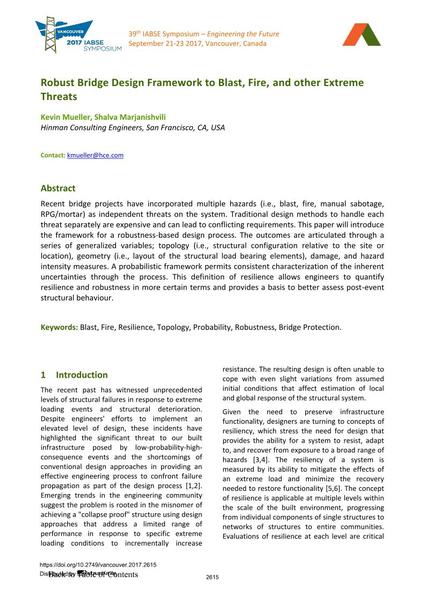Robust Bridge Design Framework to Blast, Fire, and other Extreme Threats

|
|
|||||||||||
Bibliografische Angaben
| Autor(en): |
Kevin Mueller
(Hinman Consulting Engineers, San Francisco, CA, USA)
Shalva Marjanishvili (Hinman Consulting Engineers, San Francisco, CA, USA) |
||||
|---|---|---|---|---|---|
| Medium: | Tagungsbeitrag | ||||
| Sprache(n): | Englisch | ||||
| Tagung: | IABSE Symposium: Engineering the Future, Vancouver, Canada, 21-23 September 2017 | ||||
| Veröffentlicht in: | IABSE Symposium Vancouver 2017 | ||||
|
|||||
| Seite(n): | 2615-2622 | ||||
| Anzahl der Seiten (im PDF): | 8 | ||||
| Jahr: | 2017 | ||||
| DOI: | 10.2749/vancouver.2017.2615 | ||||
| Abstrakt: |
Recent bridge projects have incorporated multiple hazards (i.e., blast, fire, manual sabotage, RPG/mortar) as independent threats on the system. Traditional design methods to handle each threat separately are expensive and can lead to conflicting requirements. This paper will introduce the framework for a robustness-based design process. The outcomes are articulated through a series of generalized variables; topology (i.e., structural configuration relative to the site or location), geometry (i.e., layout of the structural load bearing elements), damage, and hazard intensity measures. A probabilistic framework permits consistent characterization of the inherent uncertainties through the process. This definition of resilience allows engineers to quantify resilience and robustness in more certain terms and provides a basis to better assess post-event structural behaviour. |
||||
| Stichwörter: |
Robustheit Explosion Wahrscheinlichkeit Brand
|
||||
